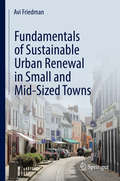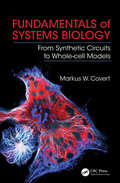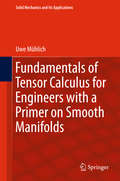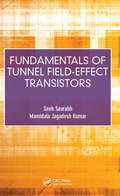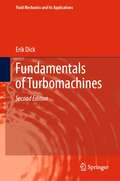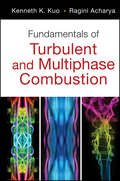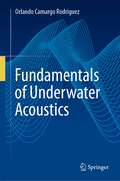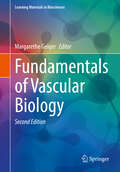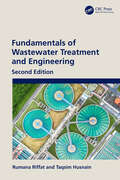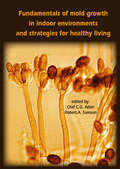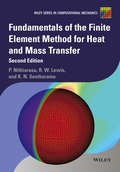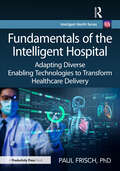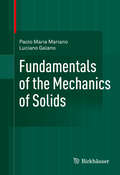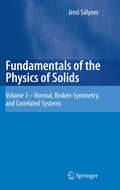- Table View
- List View
Fundamentals of Sustainable Urban Design
by Avi FriedmanThis book begins with an introduction describing current societal transformations that merit new urban designs, including depletion of non-renewable natural resources, elevated levels of greenhouse gas emissions, large numbers of aging “Baby Boomers,” and climate change. Dr. Friedman then examines these challenges through thirty chapters of interest to urban designers, architects, civil and construction engineers, and town planners. Each of these topics represents an aspect of urban design and describes an innovative solution and offers a detailed description of underlying principles. The highly illustrated text presents innovative urban design strategies based on sustainable principles. Integrated with each chapter are several international case studies illustrating design implementations.
Fundamentals of Sustainable Urban Renewal in Small and Mid-Sized Towns
by Avi FriedmanThe book introduces challenges affecting smaller urban communities with fewer than 50,000 inhabitants and offers urban planning and building/architectural strategies to strengthen their city centers. It divides urban renewal of small towns into sub-components such as environmental challenges, demographic trends, economic changes and cultural aspects, and aging infrastructure. In each, context is established, and principles are outlined and illustrated. Topics include urban form, mobility and connectivity, infill neighborhoods design, wealth generation, and promotion of local culture and well‐being. Reinforced with detailed case studies, Fundamentals of Sustainable Urban Renewal in Small and Mid‐Sized Towns is an ideal resource for municipal planners, architects, civil engineers, and policy makers.
Fundamentals of Systems Biology: From Synthetic Circuits to Whole-cell Models
by Markus W. Covert<p>For decades biology has focused on decoding cellular processes one gene at a time, but many of the most pressing biological questions, as well as diseases such as cancer and heart disease, are related to complex systems involving the interaction of hundreds, or even thousands, of gene products and other factors. How do we begin to understand this complexity? <p><i>Fundamentals of Systems Biology: From Synthetic Circuits to Whole-cell Models</i> introduces students to methods they can use to tackle complex systems head-on, carefully walking them through studies that comprise the foundation and frontier of systems biology. The first section of the book focuses on bringing students quickly up to speed with a variety of modeling methods in the context of a synthetic biological circuit. This innovative approach builds intuition about the strengths and weaknesses of each method and becomes critical in the book’s second half, where much more complicated network models are addressed—including transcriptional, signaling, metabolic, and even integrated multi-network models. <p>The approach makes the work much more accessible to novices (undergraduates, medical students, and biologists new to mathematical modeling) while still having much to offer experienced modelers--whether their interests are microbes, organs, whole organisms, diseases, synthetic biology, or just about any field that investigates living systems.</p>
Fundamentals of Tank and Process Equipment Design (Foundations of Engineering Mechanics)
by András NagyThis book offers a comprehensive guide to the design and construction of process equipment and storage tanks. It covers the theoretical fundamentals of calculation methods and dimensioning techniques used in the design process, as well as the interpretation and evaluation of finite element examination results for stress concentrating cross-sections. Additionally, the book showcases corrosion-proof design through real-world examples. All measurement and calculation results presented in the book are based on the author's original research work.
Fundamentals of Tensor Calculus for Engineers with a Primer on Smooth Manifolds
by Uwe MühlichThis book presents the fundamentals of modern tensor calculus for students in engineering and applied physics, emphasizing those aspects that are crucial for applying tensor calculus safely in Euclidian space and for grasping the very essence of the smooth manifold concept.After introducing the subject, it provides a brief exposition on point set topology to familiarize readers with the subject, especially with those topics required in later chapters.It then describes the finite dimensional real vector space and its dual, focusing on the usefulness of the latter for encoding duality concepts in physics. Moreover, it introduces tensors as objects that encode linear mappings and discusses affine and Euclidean spaces. Tensor analysis is explored first in Euclidean space, starting from a generalization of the concept of differentiability and proceeding towards concepts such as directional derivative, covariant derivative and integration based on differential forms. The final chapter addresses the role of smooth manifolds in modeling spaces other than Euclidean space, particularly the concepts of smooth atlas and tangent space, which are crucial to understanding the topic. Two of the most important concepts, namely the tangent bundle and the Lie derivative, are subsequently worked out.
Fundamentals of Thermal Radiation for Energy Utilization in Fuel Combustion (Advanced Topics in Science and Technology in China #67)
by Shiquan Shan Zhijun Zhou Yanwei ZhangThis book is in the field of Engineering Thermophysics. It first introduces the authors’ academic thoughts of photo-thermal energy cascade conversion in the fuel combustion. Afterward, a series of thermal radiation theories and models have been developed based on the aim of radiative energy utilization, including spectral radiation available energy theory, gas radiation model under complex combustion conditions, and calculation model of radiation available energy transfer in combustion medium. Based on simulation and experimental results, the radiative energy characteristics of different fuel combustion are introduced. This book develops the radiation theory of the combustion process from a new perspective, integrating theories, models, and experimental results. This book can be used as a reference for scientists, engineers, and graduate students engaged in energy environment, combustion, and thermal radiation.
Fundamentals of Thermodynamics
by Claus BorgnakkeDiscover the Basics of Thermodynamics with the Field’s Leading Textbook for over Thirty Years Thermodynamics is the branch of physics concerning the relationship between heat and temperature on the one hand, and energy, entropy, and the properties of matter on the other. Its engineering applications are innumerable, and include engine design, heat transfer, air conditioning and refrigeration, energy conversion, and more. For more than three decades, Fundamentals of Thermodynamics has served as the foundational introduction to this subject for students and interested readers. Now fully updated to incorporate the latest research and new pedagogical tools, it promises to continue as the field’s indispensable survey. Readers of the Eleventh Edition of Fundamentals of Thermodynamics will find: Detailed, step-by-step worked-through examples to facilitate learningNew material on statistical thermodynamics and other burgeoning subjectsAn expansive collection of online resources including bonus chapters, additional problem sets, study problems, and more Fundamentals of Thermodynamics is ideal for students and instructors in thermodynamics or engineering of thermodynamics at the intermediate or advanced undergraduate level.
Fundamentals of Thermodynamics
by K. Ramamurthi John H. LeeA concise treatment of the fundamentals of thermodynamics is presented in this book. In particular, emphasis is placed on discussions of the second law, a unique feature of thermodynamics, which states the limitations of converting thermal energy into mechanical energy. The entropy function that permits the loss in the potential of a real thermodynamic process to be assessed, the maximum possible work in a process, and irreversibility and equilibrium are deduced from the law through physical and intuitive considerations. They are applicable in mitigating waste heat and are useful for solving energy, power, propulsion and climate-related issues.The treatment is not restricted to properties and functions of ideal gases. The ideal gas assumption is invoked as a limiting case. Reversible paths between equilibrium states are obtained using reversible heat engines and reversible heat pumps between environment and systems to determine the entropy changes and the maximum work. The conditions of thermodynamic equilibrium comprising mechanical, thermal, chemical and phase equilibrium are addressed and the species formed at equilibrium in a chemical reaction at a given temperature and pressure are obtained. The molecular basis for the laws of thermodynamics, temperature, internal energy changes, entropy, reversibility and equilibrium are briefly discussed.The book serves as a reference for undergraduate and graduate students alongside thermodynamics textbooks.
Fundamentals of Time-Dependent Density Functional Theory
by Fernando M.S. Nogueira Miguel A.L. Marques Angel Rubio Neepa T. Maitra E.K.U. GrossThere have been many significant advances in time-dependent density functional theory over recent years, both in enlightening the fundamental theoretical basis of the theory, as well as in computational algorithms and applications. This book, as successor to the highly successful volume Time-Dependent Density Functional Theory (Lect. Notes Phys. 706, 2006) brings together for the first time all recent developments in a systematic and coherent way. First, a thorough pedagogical presentation of the fundamental theory is given, clarifying aspects of the original proofs and theorems, as well as presenting fresh developments that extend the theory into new realms--such as alternative proofs of the original Runge-Gross theorem, open quantum systems, and dispersion forces to name but a few. Next, all of the basic concepts are introduced sequentially and building in complexity, eventually reaching the level of open problems of interest. Contemporary applications of the theory are discussed, from real-time coupled-electron-ion dynamics, to excited-state dynamics and molecular transport. Last but not least, the authors introduce and review recent advances in computational implementation, including massively parallel architectures and graphical processing units. Special care has been taken in editing this volume as a multi-author textbook, following a coherent line of thought, and making all the relevant connections between chapters and concepts consistent throughout. As such it will prove to be the text of reference in this field, both for beginners as well as expert researchers and lecturers teaching advanced quantum mechanical methods to model complex physical systems, from molecules to nanostructures, from biocomplexes to surfaces, solids and liquids. From the reviews of LNP 706: "This is a well structured text, with a common set of notations and a single comprehensive and up-to-date list of references, rather than just a compilation of research articles. Because of its clear organization, the book can be used by novices (basic knowledge of ground-state DFT is assumed) and experienced users of TD-DFT, as well as developers in the field." (Anna I. Krylov, Journal of the American Chemical Society, Vol. 129 (21), 2007) "This book is a treasure of knowledge and I highly recommend it. Although it is a compilation of chapters written by many different leading researchers involved in development and application of TDDFT, the contributors have taken great care to make sure the book is pedagogically sound and the chapters complement each other [...]. It is highly accessible to any graduate student of chemistry or physics with a solid grounding in many-particle quantum mechanics, wishing to understand both the fundamental theory as well as the exponentially growing number of applications. [...] In any case, no matter what your background is, it is a must-read and an excellent reference to have on your shelf." Amazon.com, October 15, 2008, David Tempel (Cambridge, MA)
Fundamentals of Tunnel Field-Effect Transistors
by Mamidala Jagadesh Kumar Sneh SaurabhDuring the last decade, there has been a great deal of interest in TFETs. To the best authors’ knowledge, no book on TFETs currently exists. The proposed book provides readers with fundamental understanding of the TFETs. It explains the interesting characteristics of the TFETs, pointing to their strengths and weaknesses, and describes the novel techniques that can be employed to overcome these weaknesses and improve their characteristics. Different tradeoffs that can be made in designing TFETs have also been highlighted. Further, the book provides simulation example files of TFETs that could be run using a commercial device simulator.
Fundamentals of Turbomachines (Fluid Mechanics and Its Applications #130)
by Erik DickThis textbook explores the working principles of all kinds of turbomachines. The same theoretical framework is used to analyze the different machine types. The order in which the different kinds are treated is chosen by the possibility of gradually building up theoretical concepts. For each of the turbomachine kinds, a balance is sought between fundamental understanding and knowledge of practical aspects. Readers are invited through challenging exercises to consider how the theory applies to particular cases. This textbook appeals to senior undergraduate and graduate students in mechanical engineering and to professional engineers seeking to understand the operation of turbomachines. Readers will gain a fundamental understanding of turbomachines and will be able to make a reasoned choice of a turbomachine for a particular application.
Fundamentals of Turbulent and Multi-Phase Combustion
by Kenneth Kuan-yun Kuo Ragini AcharyaDetailed coverage of advanced combustion topics from the author of Principles of Combustion, Second EditionTurbulence, turbulent combustion, and multiphase reacting flows have become major research topics in recent decades due to their application across diverse fields, including energy, environment, propulsion, transportation, industrial safety, and nanotechnology. Most of the knowledge accumulated from this research has never been published in book form-until now. Fundamentals of Turbulent and Multiphase Combustion presents up-to-date, integrated coverage of the fundamentals of turbulence, combustion, and multiphase phenomena along with useful experimental techniques, including non-intrusive, laser-based measurement techniques, providing a firm background in both contemporary and classical approaches. Beginning with two full chapters on laminar premixed and non-premixed flames, this book takes a multiphase approach, beginning with more common topics and moving on to higher-level applications.In addition, Fundamentals of Turbulent and Multiphase Combustion: Addresses seven basic topical areas in combustion and multiphase flows, including laminar premixed and non-premixed flames, theory of turbulence, turbulent premixed and non-premixed flames, and multiphase flows Covers spray atomization and combustion, solid-propellant combustion, homogeneous propellants, nitramines, reacting boundary-layer flows, single energetic particle combustion, and granular bed combustion Provides experimental setups and results whenever appropriateSupported with a large number of examples and problems as well as a solutions manual, Fundamentals of Turbulent and Multiphase Combustion is an important resource for professional engineers and researchers as well as graduate students in mechanical, chemical, and aerospace engineering.
Fundamentals of Ultrasonic Testing (Space Science, Technology and Application Series)
by Weibin Li Chunguang XuFocusing on the theory and state-of-the-art technologies of ultrasonic testing (UT), this book examines ultrasonic propagation in solids and its detection applications, and explores the intersection of UT technology with various fields of electromagnetics, optics and physics.UT is one of the most widely used nondestructive testing techniques due to its high performance in terms of detection efficiency and safety. The rapid development of modern industrial products and technologies has created a new challenge and demand for ultrasonic nondestructive testing technology. This book introduces the fundamentals of UT, including sound wave and sound field, interface wave theory and liquid-solid coupled sound field. It then discusses various types of UT methods, ranging from the critically refracted longitudinal wave method to ultrasonic surface wave and ultrasonic guided wave detection methods. Some newly developed UT techniques are also discussed, including phased-array UT, high-frequency UT and non-contact UT.This title will appeal to engineering students and technicians in the field of ultrasonic nondestructive testing.
Fundamentals of Underwater Acoustics
by Orlando Camargo RodríguezThis textbook on Underwater Acoustics has a structure that is more organic than logical. It thereby unifies diverse areas of research, including topics of signal processing, the sonar equation, sources and receivers, scattering and reverberation, wave propagation, propagation models, and inverse problems. It also provides code fragments written in Python which complement the discussion. This is a book written for both beginners and specialists, as well as for biologists, oceanographers, computer engineers, physicists, and mathematicians, and for civilian and naval personnel who are looking for a introductory overview of the topic.
Fundamentals of Vascular Biology (Learning Materials in Biosciences)
by Margarethe GeigerThis well-structured textbook offers essential knowledge on the vascular system. The reader will learn the properties, basic cellular mechanisms and development of the different parts of the vascular system (including the heart), gain knowledge on vascular and related diseases, and will be made familiar with common and most current methods and techniques applied to analyze the vascular system in patients, in animal models, and ex vivo. This book is based on a PhD Course for students from various bioscientific backgrounds given at the Medical University of Vienna, and it will be a valuable resource for Master´s Students in vascular biology and biomedicine in general and a helpful tool for young researchers world-wide wishing to gain or refresh their knowledge in this field.
Fundamentals of Vascular Biology (Learning Materials in Biosciences)
by Margarethe GeigerThis is a fully revised Second Edition of a well-structured textbook that offers essential knowledge on the vascular system. The reader will learn the properties, basic cellular mechanisms, and development of the different parts of the vascular system (including the heart and lung), gain knowledge on vascular and related diseases, and will be made familiar with common and most current methods and techniques applied to analyze the vascular system in patients, animal models, and ex vivo. This book is based on a Ph.D. Course for students from various scientific backgrounds given at the Medical University of Vienna, and it will be a valuable resource for Master´s Students in vascular biology and biomedicine in general and a helpful tool for young researchers worldwide wishing to gain or refresh their knowledge in this field.
Fundamentals of Wastewater Treatment and Engineering
by Rumana Riffat Taqsim HusnainThe 2nd edition of Fundamentals of Wastewater Treatment and Design introduces readers to the fundamental concepts of wastewater treatment, followed by engineering design of unit processes for sustainable treatment of municipal wastewater and resource recovery. It has been completely updated with new chapters to reflect current advances in design, resource recovery practices and research. Another highlight is the addition of the last chapter, which provides a culminating design experience of both urban and rural wastewater treatment systems. Filling the need for a textbook focused on wastewater, it covers history, current practices, emerging concerns, future directions and pertinent regulations that have shaped the objectives of this important area of engineering. Basic principles of reaction kinetics, reactor design and environmental microbiology are introduced along with natural purification processes. It also details the design of unit processes for primary, secondary and advanced treatment, as well as solids processing and removal. Recovery of water, energy and nutrients are explained with the help of process concepts and design applications. This textbook is designed for undergraduate and graduate students who have some knowledge of environmental chemistry and fluid mechanics. Professionals in the wastewater industry will also find this a handy reference.
Fundamentals of Water Security: Quantity, Quality, and Equity in a Changing Climate
by Jim F. Chamberlain David A. SabatiniFUNDAMENTALS OF WATER SECURITY Understand How to Manage Water Resources to Equitably Meet Both Human and Ecological Needs Burgeoning populations and the ever-higher standards of living for those in emerging countries increase the demand on our water resources. What is not increasing, however, is the supply of water and the total amount of water in earth’s biosphere—water that is integral to all standards of living. Fundamentals of Water Security provides a foundation for understanding and managing the quantity-quality-equity nexus of water security in a changing climate. In a broad sense, this volume explores solutions to water security challenges around the world. It is richly illustrated and pedagogically packed with up-to-date information. The text contains chapter learning objectives, foundation sections reviewing quantitative skills, case studies, and vignettes of people who have made important contributions to water security. To further aid comprehension, end-of-chapter problems are included—both qualitative and quantitative, with solutions available to instructors. Finally, extensive references feature books, journal articles, and government and NGO reports. Sample topics discussed include: How the study of water resources has evolved from a focus on physical availability to include social factors and governance How water security affects multiple disciplines across environmental science and engineering, hydrology, geography, water resources, atmospheric science, chemistry, biology, health science, and social and political science fields How to achieve a sufficient quantity and quality of water to equitably meet both immediate and long-term human and ecological needs Analysis of water security in an integrated manner by underscoring the complex interactions between water quantity, water quality, and society Students taking courses on hydrology, water security, and/or water resource management, along with scientists working in fields where water security is a factor will be able to use Fundamentals of Water Security as a comprehensive textbook to understand and achieve water security.
Fundamentals of mold growth in indoor environments and strategies for healthy living
by Olaf C.G. Adan Robert A. SamsonToday, indoor mold and moisture, and their associated health effects, are a society-wide problem. The economic consequences of indoor mold and moisture are enormous. Their global dimension has been emphasized in several recent international publications, stressing that the most important means for avoiding adverse health effects is the prevention (or minimization) of persistent dampness and microbial growth on interior surfaces and in building structures. This book aims to describe the fundamentals of indoor mold growth as a prerequisite to tackle mold growth in the existing building stock as well as in future energy efficient buildings. It brings together different disciplinary points of view on indoor mold, ranging from physics and material science to microbiology and health sciences. The contents have been outlined according to three main issues: Fundamentals, particularly addressing the crucial roles of water and materials, Health, including a state-of-the-art description of the health-related effects of indoor molds, and Strategies, integrating remediation, prevention and policies.
Fundamentals of the Finite Element Method for Heat and Mass Transfer
by Perumal Nithiarasu Kankanhalli N. Seetharamu Roland W. LewisFundamentals of the Finite Element Method for Heat and Mass Transfer, Second Edition is a comprehensively updated new edition and is a unique book on the application of the finite element method to heat and mass transfer.<P><P> • Addresses fundamentals, applications and computer implementation<P> • Educational computer codes are freely available to download, modify and use<P> • Includes a large number of worked examples and exercises<P> • Fills the gap between learning and research
Fundamentals of the Intelligent Hospital: Adapting Diverse Enabling Technologies to Transform Healthcare Delivery (Intelligent Health Series)
by Paul Frisch, PhDOver the last decade the changing healthcare environment has driven hospitals to critically evaluate and optimize their operations to enhance patient treatment and care prompting the emergence of the intelligent health system. Unlike traditional health systems, intelligent health systems are emerging as entities that leverage data, AI, the cloud and other digital tools to create strategic advantages and better outcomes. While all health systems claim to be doing this, there is a different approach used by intelligent health systems. Both models recognize the inherent power of using data and AI to improve the delivery of health services, but intelligent health systems are this this to the next level. They are using the intelligent health revolution to rethink the entire delivery model. Their focus is on leveraging AI and other technologies to efficiently provide health and medical services across all touchpoints, experiences and channels. To deal with the complexity of patient care workflows, enhance patient diagnosis, treatment, care, safety and satisfaction, home health and telemedicine the design of Intelligent Hospitals has focused on the integration of diverse technologies, to provide a seamless exchange of information. This book outlines the technologies and clinical applications which constitute the fundamentals of the Intelligent Hospital and the technologies that support patient care and health management across a spectrum of healthcare environments, the home, remote offices and treatment facilities and the hospital itself. The book introduces the changing environment of care resulting in new distributions of patients across a broad spectrum of the patient acuity and care environments, including the Intelligent Hospital; supporting treatment areas, such as the OR, Radiation Therapy, interventional radiology, patient care areas, such as the ICU, ambulatory / telemetry as well as all supporting functionality, including infection control, laboratory medicine, pathology, biomedical engineering, Informatics and Information Technology; I-Home supporting networked dynamically interact with the technologies and application in a variety of care settings. Each chapter describes the fundamentals of integrating diverse technologies and clinical systems to create a seamless environment enabling data to be share across the complete spectrum care environment, starting from the ambulance, through the emergency room, diagnostics, treatment and recovery in the hospital to the home environment. The book highlights and details specific topics, including medical devices and applications, RFID, network and wireless infrastructure; interoperability and integrations, artificial intelligence and much more with a focus on connectivity, integrations and architecture to create a seamless environment.
Fundamentals of the Mechanics of Solids
by Paolo Maria Mariano Luciano GalanoThis distinctive textbook aims to introduce readers to the basic structures of the mechanics of deformable bodies, with a special emphasis on the description of the elastic behavior of simple materials and structures composed by elastic beams. The authors take a deductive rather than inductive approach and start from a few first, foundational principles. A wide selection of exercises, many with hints and solutions, are provided throughout and organized in a way that will allow readers to form a link between abstract mathematical concepts and real-world applications. The text begins with the definition of bodies and deformations, keeping the kinematics of rigid bodies as a special case; the authors also distinguish between material and spatial metrics, defining each one in the pertinent space. Subsequent chapters cover observers and classes of possible changes; forces, torques, and related balances, which are derived from the invariance under classical changes in observers of the power of the external actions over a body, rather than postulated a priori; constitutive structures; variational principles in linear elasticity; the de Saint-Venant problem; yield criteria and a discussion of their role in the representation of material behavi∨ and an overview of some bifurcation phenomena, focusing on the Euler rod. An appendix on tensor algebra and tensor calculus is included for readers who need a brief refresher on these topics. Fundamentals of the Mechanics of Solids is primarily intended for graduate and advanced undergraduate students in various fields of engineering and applied mathematics. Prerequisites include basic courses in calculus, mathematical analysis, and classical mechanics.
Fundamentals of the Physical Environment: Fourth Edition
by Peter Smithson Ken Addison Ken AtkinsonFundamentals of the Physical Environment has established itself as a well-respected core introductory book for students of physical geography and the environmental sciences. Taking a systems approach, it demonstrates how the various factors operating at Earth’s surface can and do interact, and how landscape can be used to decipher them. The nature of the earth, its atmosphere and its oceans, the main processes of geomorphology and key elements of ecosystems are also all explained. The final section on specific environments usefully sets in context the physical processes and human impacts. This fourth edition has been extensively revised to incorporate current thinking and knowledge and includes: a new section on the history and study of physical geography an updated and strengthened chapter on climate change (9) and a strengthened section on the work of the wind a revised chapter (15) on crysosphere systems - glaciers, ice and permafrost a new chapter (23) on the principles of environmental reconstruction a new joint chapter (24) on polar and alpine environments a key new joint chapter (28) on current environmental change and future environments new material on the Earth System and cycling of carbon and nutrients themed boxes highlighting processes, systems, applications, new developments and human impacts a support website at www.routledge.com/textbooks/9780415395168 with discussion and essay questions, chapter summaries and extended case studies. Clearly written, well-structured and with over 450 informative colour diagrams and 150 colour photographs, this text provides students with the necessary grounding in fundamental processes whilst linking these to their impact on human society and their application to the science of the environment.
Fundamentals of the Physical Theory of Diffraction
by Pyotr Ya. UfimtsevA complete presentation of the modern physical theory of diffraction and its applications, by the world's leading authority on the topicExtensive revisions and additions to the first edition yield a second edition that is 492 pages in length, with 122 figuresNew sections examine the nature of polarization coupling, and extend the theory of shadow radiation and reflection to opaque objectsThis book features end-of-chapter problems and a solutions manual for university professors and graduate studentsMATLAB codes presented in appendices allow for quick numeric calculations of diffracted waves
Fundamentals of the Physics of Solids
by Jenö SólyomThis book is the third of a three-volume series written by the same author. It aims to deliver a comprehensive and self-contained account of the fundamentals of the physics of solids. In the presentation of the properties and experimentally observed phenomena together with the basic concepts and theoretical methods, it goes far beyond most classic texts. The essential features of various experimental techniques are also explained. This volume is devoted mostly to the discussion of the effects of electron--electron interaction beyond the one-electron approximation. The density-functional theory is introduced to account for correlation effects. The response to external perturbations is discussed in the framework of linear response theory. Landau's Fermi-liquid theory is followed by the theory of Luttinger liquids. The subsequent chapters are devoted to electronic phases with broken symmetry: to itinerant magnetism, to spin- and charge-density waves and their realizations in quasi-one-dimensional materials, as well as to the microscopic theory of superconductivity. An overview is given of the physics of strongly correlated systems. The last chapter covers selected problems in the physics of disordered systems.

